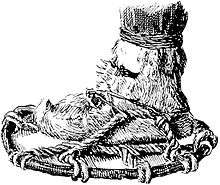Finneskoe

Sami Finneskoe, along with snowshoes, used in Fridtjof Nansen's Greenland expedition of 1890.
Finneskoe (also Finnesko) is a soft hide boot used for cold climate travel. Because it is soft it will not freeze as solidly as thick boot leather and so can be put on relatively easy after being left overnight in subzero conditions.[1]
Originally from Lapland, they were traditionally made from reindeer skin stuffed with grass (such as sennegrass) for insulation and water absorption. From 1890 they are regularly mentioned in accounts of polar travel[2][3]
The name comes from the Norwegian Finn (Lapp) + sko (shoe).[4] This type of boot made by the Sami people of Norway are called Skaller.[5]
See also
Traditional Sami reindeer boots, Thornews.com
References
- ↑ Hince, Bernadette (2000). The Antarctic Dictionary: A Complete Guide to Antarctic English. CSIRO Publishing. ISBN 0 9577471 1X.
- ↑ Shackleton, Ernest (1998). South: A Memoir of the Endurance Voyage. Robinson. ISBN 1841190349.
- ↑ Scott, Captain Robert F. (1905). The Voyage of the 'Discovery'. London: Macmillan and Co. p. 244.
- ↑ Hince, Bernadette (2000). The Antarctic Dictionary: A Complete Guide to Antarctic English. CSIRO Publishing. ISBN 0 9577471 1X.
- ↑ Thornews editorial staff (August 25, 2013). "Traditional Sami Reindeer Fur Boots: Skaller". ThorNews.com. ThorNews.com. Retrieved 13 November 2016.
This article is issued from Wikipedia - version of the 11/21/2016. The text is available under the Creative Commons Attribution/Share Alike but additional terms may apply for the media files.